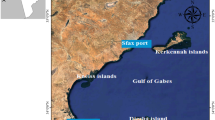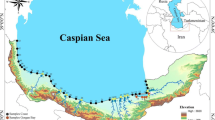Abstract
Metals are among the most common environmental pollutants, and their presence in high concentration in waters and biota have devastating effects on flora, fauna, and human health. Flocculation process of metals during estuarine mixing can reduce the environmental hazards of metals and also can provide micronutrients to the aquatic system. The present investigation provides a thorough study of eliminating colloidal elements of copper, manganese, nickel, lead, and zinc during estuarine mixing of Shalmanrood River water with Caspian Sea water in Iran. The processes of flocculation were carried out in six different salinity regimes (0.45–2.4 ppt). The obtained result is indicative of non-conservative behavior of the studied metals. Higher flocculation resulted in a lower salinity regime. The obtained results indicated that most of the metals were eliminated during the initial mixing of fresh water with sea water at 0.45–0.9 ppt salinity interval. The trend of flocculation rates of elements is as follows: Zn (59.3%) > Pb (47.6%) > Mn (37.5%) > Cu (29.2%) > Ni (27%).The annual average load of copper (Cu), manganese (Mn), nickel (Ni), lead (Pb), and zinc (Zn) from Shalmanrood River to Caspian Sea decreases as a result of flocculation process from 9.9, 7.7, 8.9, 5.1, and 23.2 tons per year to 7, 4.8, 6.5, 2.7, and 9.4 tons per year, respectively. According to the cluster analysis, parameters such as temperature, pH, and Eh do not have any impact on flocculation of elements expect for Pb. The only parameter that influences the flocculation of Mn is the salinity. Metal speciation studies that are carried out by Eh-pH software show that the studied metals are present as oxides (Zn, Cu, and Ni) and hydroxides (Mn and Pb).



Similar content being viewed by others
References
Anderson AJB (1971) Numeric examination of multivariate soil samples. Math Geol 3:1–14
Biati A, Karbassi AR, Hassani AH, Monavari SM, Moattar F (2010a) Role of metal species in flocculation rate during estuarine mixing. Int J Environ Sci Technol 7:327–336
Biati A, Moattar F, Karbassi AR, Hassani AH (2010b) Role of saline water in removal of heavy elements from industrial wastewaters. Int J Environ Res 4:169–176
Boyle EA, Edmond JM, Sholkovitz ER (1977) The mechanism of Fe removal in estuaries. Geochim Cosmochim Acta 41:1313–1324
Chenar SHSH, Karbassi AR, Zaker NH, Ghazban F (2013) Electroflocculation of metals during estuarine mixing (Caspian Sea). J Coast Res 29:847–854
Davis JB (1973) Statistic and data analysis in geology. Wiley, New York
Eckert JM, Sholkovitz ER (1976) The flocculation of iron, aluminium and humates from river water by electrolytes. Geochim Cosmochim Acta 40:847–856
Featherstone AM, O’Grady BV (1997) Removal of dissolved copper and iron at the freshwater–saltwater interface of an acid mine stream. Mar Pollut Bull 34:332–337
Hunter KA (1983) On the estuarine mixing of dissolved substances in relation to colloidal stability and surface properties. Geochim Cosmochim Acta 47:467–473
Karbassi AR, Heidari M (2015a) An investigation on role of salinity, pH and DO on heavy metals elimination throughout estuarial mixture. Global J Environ Sci Manage 1:41–46
Karbassi AR, Fakhraee M, Vaezi AR, Bashiri A, Heidari M (2015b) An investigation on flocculation, adsorption and desorption process during mixing of saline water with fresh water (Caspian Sea). J Environ Stud 41(2): 331–340
Karbassi AR, Nadjafpour SH (1996) Flocculation of dissolved Pb, Cu, Zn, and Mn during estuarine mixing of river water with the Caspian Sea. Environ Pollut 93:257–260
Karbassi AR, Nouri J, Ayaz GO (2007) Flocculation of trace metals during mixing of Talar River water with Caspian Seawater. Int J Environ Res 1:66–73
Karbassi AR, Nouri J, Mehrdadi N, Ayaz GO (2008) Flocculation of heavy metals during mixing of freshwater with Caspian Seawater. Environ Geol 53:1811–1816
Karbassi AR, Heidari M, Vaezi AR, Valikhani Samani AR, Fakhraee M, Heidari F (2013) Effect of pH and salinity on flocculation process of heavy metals during mixing of Aras River water with Caspian Sea water. Environ Earth Sci 72:457–465
Karbassi AR, Fakhraee M, Heidari M, Vaezi AR, Valikhani Samani AR (2014) Dissolved and particulate trace metal geochemistry during mixing of Karganrud River with Caspian Sea water. Arab J Geosci 8:2143–2151
Karbassi AR, Tajziehchi S, Farhang Adib N (2016) Role of estuarine natural processes in removal of trace metals under emergency situations. Global J. Environ. Sci. Manage 2(1):31–38
Meybeck M (1982) Carbon, nitrogen and phosphorus transport by world rivers. Am J Sci 282:401–450
Pritchard DW (1967) What is an estuary: physical viewpoint? In: Estuaries. AAAS, Washington DC, p 3–5
Saeedi M, Karbassi AR, Mehrdadi N (2003) Flocculation of dissolved Mn, Zn, Ni and Cu during the estuarine mixing of Tadjan River water with Caspian Seawater. Int J Environ Stud 60:567–576
Takeno N (2005) Atlas of Eh-pH diagrams. Geological survey of Japan open file report 419:102
Shokovitz ER (1976) Flocculation of dissolved organic and inorganic matter during the mixing river water and seawater. Geochim Cosmochim Acta 40:831–845
Vaezi AR, Karbassi AR, Fakhraee M, Valikhani Samani AR, Heidari M (2014) Assessment of Sources and Concentration of Metal Contaminants in Marine Sediments of Musa Estuary, Persian Gulf. J Environ Stud 40(2):345–360
Vaezi AR, Karbassi AR, KokabiHabibzadeh S, Heidari M (2016) Heavy metal contamination and risk assessment in the riverine sediment. Indian J Geo-Mar Sci 45:1017–1023
Valikhani Samania AR, Karbassi AR, Fakhraeea M, Heidari M, Vaezia AR, Valikhani Z (2014) Effect of dissolved organic carbon and salinity on flocculation process of heavy metals during mixing of the Navrud River water with Caspian Seawater. Desalin Water Treat 55:926–934
Zhiqing LE, Jianhu Z, Jinsi C (1987) Flocculation of dissolved Fe, Al, Mn, Si, Cu, Pb and Zn during estuarine mixing. Acta Oceanol Sin 6:567–576
Acknowledgements
We are grateful to representative of the environment faculty of Tehran University for giving aid to us to produce a pivotal remedy to resolve challenges we are faced with it in doing such a research in an accurate manner.
Author information
Authors and Affiliations
Corresponding author
Additional information
Responsible editor: Philippe Garrigues
Rights and permissions
About this article
Cite this article
Farajnejad, H., Karbassi, A. & Heidari, M. Fate of toxic metals during estuarine mixing of fresh water with saline water. Environ Sci Pollut Res 24, 27430–27435 (2017). https://doi.org/10.1007/s11356-017-0329-z
Received:
Accepted:
Published:
Issue Date:
DOI: https://doi.org/10.1007/s11356-017-0329-z




